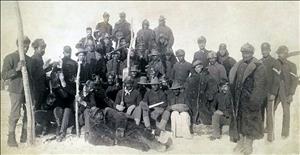On July 8, 1904, after completing a 275-mile trek from Fort Walla Walla to Camp Nisqually, Buffalo Soldiers from the 9th Cavalry Regiment begin their participation in the American Lake Maneuvers, the largest military gathering on the West Coast up to that point. The Buffalo Soldiers had been created by the United States Congress on July 28, 1866, as segregated, all-Black, peacetime regiments. The units existed from 1866 through 1943 as the 9th and 10th Cavalry Regiment and the 24th and 25th Infantry units, after which they no longer rode horses, but remained segregated military units. In 1948 President Harry Truman ordered the desegregation of the military and over the next several years the remaining Buffalo Soldiers were for the first time placed in racially integrated units.
Buffalo Soldiers
The first units of Buffalo Soldiers were used primarily as tools of westward expansion after the abolition of slavery. The soldiers served widely in conflicts against America's indigenous population, including during the Indian Wars. They managed tribal relations on a daily basis and protected settlers, travelers, the mail, wagon trains, and cattle, filling the functions of agencies that were yet to be created. The units built much of the infrastructure needed for westward expansion, including forts, telegraph lines, and roads.
Buffalo Soldiers also worked in the establishment and early staffing of the national parks, serving as park rangers and fire fighters, and they helped guard the Mexican-American border in World War I. Even though they were considered some of the best-trained regiments in the army, they were often relegated to infrastructure jobs. The Buffalo Soldiers are rumored to have gotten the nickname from the Plains tribes, either because the texture of the men's hair was thought to resemble that of a buffalo, or because of their determination in battle.
The DuPont Encampment
In 1904 the 9th Cavalry Regiment was stationed at the underutilized Fort Walla Walla when it was ordered to bivouac at Camp Nisqually, 275 miles distant, to participate in training maneuvers. The Lakewood area was chosen because it had so many different kinds of terrain for maneuvers and was ideally located. The 1904 American Lake Maneuvers involved 4,011 racially integrated troops and National Guardsmen and led to the creation in 1917 of Camp Lewis (later Join Base Lewis-McChord). They were an early experiment in desegregation, but that would not became a reality for another 40 years, when President Harry Truman ordered all branches of the military to integrate. This led to the Buffalo Soldier units being disbanded in 1951.
The 9th Cavalry Regiment was led by Colonel Nobles and Major Ewin. The troops traveled on horseback and crossed Stampede Pass before stopping to rest in Murray, Washington. They left Murray, reached Tacoma in time for a Fourth of July parade, then headed to Camp Nisqually to bivouac on the bank of Sequalitchew Creek. The maneuvers with the Washington, Idaho, and Oregon national guards took place over the course of 10 days, from the 8th to the 17th of July, but the 9th Cavalry was ordered to bivouac there for three months. The American Lake Maneuvers marked the first joint maneuvers between the army and the Washington National Guard, the first time a Black unit had been invited to participate in a military exercise, and the largest military gathering on the West Coast up to that point.
Legacy
The American Lake Maneuvers and subsequent military exercises in the area over the next eight years convinced the army to establish Camp Lewis there in 1917. The Buffalo Soldiers received very little press attention during their presence in Washington, but the city of DuPont, where the encampment was located, has worked to recognize and preserve their history, naming streets after Buffalo Soldiers and conducting studies of the encampment site. An archeological investigation in 1989 discovered about 800 artifacts, including horseshoes, horseshoe nails, and horse teeth. The area investigated spanned 738 feet by 328 feet and was likely used as a temporary horse stable.
In the early 2000s, William Jones (1918-2009), a former Buffalo Soldier who was stationed at Fort Lewis, opened the 9th & 10th Horse Cavalry Buffalo Soldiers Museum in Tacoma. The museum displays his memorabilia and preserves the history of the Buffalo Soldiers and their crucial service. After Jones's death in 2009, his eldest daughter, Jackie Jones-Hook, took over the operation of the museum and continued the effort to increase the public's awareness of these Black soldiers and their long history.

